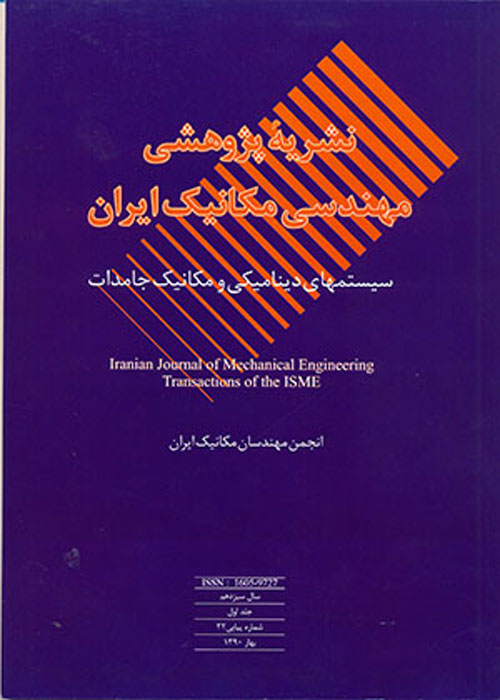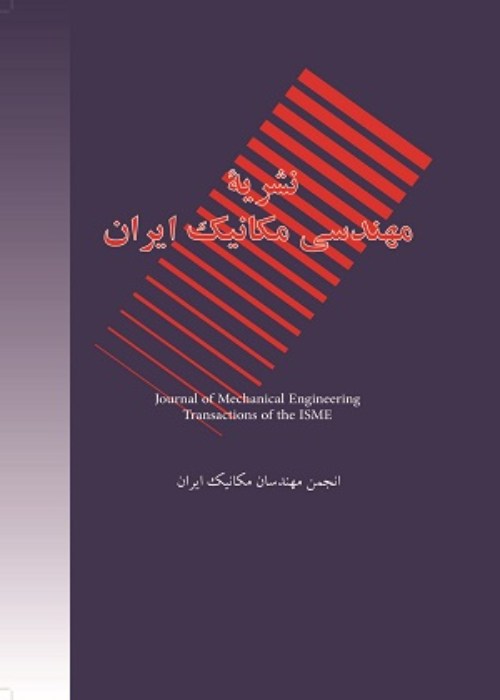فهرست مطالب

نشریه مهندسی مکانیک ایران
سال نوزدهم شماره 4 (پیاپی 49، زمستان 1396)
- تاریخ انتشار: 1396/11/24
- تعداد عناوین: 6
-
-
صفحات 6-17در این مقاله جریان لایه های سیال بینگهام در یک لوله مخروطی همگرا مورد بررسی قرار گرفته است. برای این منظور معادله ساختاری سیال بینگهام برای مدلسازی رفتار سیالات دارای تنش تسلیم به کار گرفته شده است. با فرض کوچک بودن شیب لوله، گرادیان فشار در داخل لوله برای این سیال به صورت تحلیلی تعیین شده است. با توجه به وابستگی جریان سیال به تنش تسلیم، در داخل لوله ناحیه های بوجود میآید که تانسور نرخ کرنش در آن برابر با صفر است و با عنوان ناحیه پلاگ شناخته میشود. با استفاده از گرادیان فشار بدست آمده، ناحیه پلاگ در داخل لوله تعیین و سپس با حل معادلات حرکت در مختصات استوانه های و با فرض تقارن محوری توزیع سرعت در مقطع لوله در هر دو ناحیه پلاگ و خارج از ناحیه پلاگ بدست آمده است. نتایج بدست آمده در این مقاله با نتایج ازمایشگاهی موجود در سابقه علمی و نتایج حل عددی نرم افزار فلونت مقایسه شده است. مقایسه این نتایج نشان دهنده تطابق حل تحلیلی این مقاله و نتایج آزمایشگاهی موجود در سوابق علمی مربوطه است. در نهایت اثر پارامترهای مختلف مانند تنش تسلیم و شیب لوله بر روی توزیع سرعت و ناحیه پلاگ لوله مورد بررسی قرار گرفته است.کلیدواژگان: سیال غیرنیوتنی، تحلیل جریان، لوله مخروطی، مدل بینگهام، ناحیه ی پلاگ
-
صفحات 18-35در این مقاله به بررسی یک نوع آب شیرین کنخورشیدی تبخیری به منظور شیرین سازی آب شور پرداخته شده است. از اهداف اصلی این مقاله ساخت تجربی دستگاه آب شیرین کن با بهره گیری از فناوری های پنل خورشیدی و لوله حرارتی همزمان در یک سیستم می باشد، ظرفیت تولید آب شیرین 1،5 لیتر در روز و توان پنل خورشیدی 80 وات می باشد. با توجه به بازده پایین تبدیل انرژی خورشیدی به الکتریکی توسط سیستم فتوولتاییک، انرژی تلف شده در این سیستم توسط لوله حرارتی بازیابی می گردد تا علاوه بر کاهش دمای صفحه فتوولتاییک سبب افزایش راندمان آن شود.کلیدواژگان: آب شیرین کن خورشیدی تبخیری، لوله حرارتی، پنل خورشیدی، عمق بهینه آب
-
صفحات 36-52سیستم تبرید تراکمی خورشیدی برای ماه ها و دماهای مختلف تبخیر در اصفهان مورد بررسی قرار گرفته است، که توسط نرم افزار ترنسیس شبیه سازی شده است. ظرفیت بار سرمایشی ساعتی از یک ساختمان نمونه در روز های مختلف مشخص شده است. ساعات افزایش حرارت کلی از ساختمان نمونه و نیز تغییرات ساعتی پارامترهای مختلف محاسبه شده است. حداقل مساحت سطح پنل فتوولتائیک برای پاسخ گویی به تقاضای برق کمپرسور مشخص شده است. با انجام محاسبات اقتصادی مشخص گردید که اضافه کردن سیستم خورشیدی، صرفه اقتصادی دارد. همچنین در مصرف سالانه کربن به مقدار 1241 کیلوگرم صرفه جویی می شود.کلیدواژگان: شبیه سازی، تحلیل ترمواکونومیک، تبرید تراکمی خورشیدی، ردیاب، ترنسیس
-
صفحات 53-74عملگر پلاسمایی از کارآمدترین و مطمئن ترین روش های کنترل فعال جریان سیال شناخته می شود. یکی از مدل های عددی برای شبیه سازی اثر عملگر بر جریان سیال، مدل سوزن-هوانگ است که در آن با حل دو معادله بیضوی برای پتانسیل الکتریکی و غلظت شارژ، اثر عملگر به صورت ترم های چشمه به معادلات ناویر-استوکس افزوده می گردد. در این پژوهش شرط مرزی جدیدی برای توزیع شارژ بر روی سطح دی الکتریک پیشنهاد می شود که ارتباطی را میان دو معادله بیضوی برقرار می کند. نتایج مطالعه نشان می دهند مدل ارتقایافته در شبیه سازی ساختار لایه مرزی کنترل شده در جریان عبوری از ایرفویل و صفحه تخت دارای دقت بالایی است.کلیدواژگان: عملگر پلاسمایی، کنترل فعال جریان سیال، مدل سوزن، هوانگ، ارتقای شرط مرزی
-
صفحات 75-100در این مقاله، انتقال حرارت جابجایی طبیعی دو بعدی در محفظه مربعی همراه با دو گرمکن موضعی در دیواره پایین که تحت شار حرارتی نوسانی قرار دارد، با استفاده از روش شبکه بولتزمن مورد بررسی قرار گرفته است. دیواره بالایی در محفظه در دمای ثابت سرد بوده و دیواره های جانبی و اطراف گرمکن ها نیز عایق هستند. اثر تغییرات مکان گرمکن ها، دامنه و طول موج نوسان شار حرارتی بر روی دمای ماکزیمم گرمکن ها و جریان درون محفظه بررسی شده است. نتایج نشان می دهد که با نزدیک شدن گرمکن ها به دیواره های جانبی، دمای ماکزیمم گرمکن ها اختلاف کمتری داشته و پایدارتر خواهد بود.کلیدواژگان: روش شبکه بولتزمن، شار حرارتی نوسانی، جابجایی طبیعی، محفظه مربعی
-
صفحات 101-122درون سیکلون های گازی جریان پیچیده ای با شدت چرخش بسیار بالا حکمفرما می باشد که متحمل نرخ تنش-کرنش زیادی است. برای شبیه سازی فاز گاز از مدل آشفته RSM و برای ارزیابی عملکرد ذرات کربنات کلسیم از روش آماری اویلری-لاگرانژی استفاده شده است. در این مطالعه با تغییر ارتفاع بخش جداسازی در سیکلون تغییر در الگوی جریان و عملکرد آن بررسی می شود. با افزایش ارتفاع استوانه سیکلون سرعت مماسی و ناحیه ورتکس کاهش می یابند. از سوی دیگر افزایش این پارامتر هندسی موجب افزایش نرخ جریان پایین دست در سرعت محوری، افزایش افت فشار و همچنین افزایش عملکرد سیکلون را به دنبال دارد.کلیدواژگان: مدل آشفته RSM، اویلری، لاگرانژی، سیکلون گاز، ذره، جریان آشفته
-
Pages 6-17In this paper the laminar Bingham fluid flow through a converging conical duct is analyzed. The constitutive law of Bingham fluids is applied to model the yield dependent properties behavior of the fluid. An analytical solution is obtained for the pressure gradient assuming small conical angle of the duct. According to the yield dependent properties of the fluid, a region is developed in the fluid wherein the rate of deformation tensor is zero. This region is called plug region. According to obtained pressure gradient, the plug region is determined. Then, assuming the cylindrical symmetry, the governing equations are solved in cylindrical coordinate system and velocity field is obtained across the duct section. The results obtained in the paper is compared with the experimental data given in the literature search and Fluent numerical solution. The comparison of these two methods shows that the result of current paper is well compared with those given in the literature search. Finally, the effect of parameters such as yield strength and conical angle on velocity field and plug region is investigated.Keywords: Non-Newtonian Fluid, Flow analysis, Conical Duct, Bingham Model, Plug region
-
Pages 18-35With regard to the ever growing world population and the constant capacity of water resources, novel and trusted methods need to be implemented to preserve freshwater resources and also produce drinking water. In this study, an investigation was performed on a type of evaporation-based solar desalination system which was used to desalinate saline water. Among the aims of this study was the fabrication of a desalination system with the help of both solar panel and heat pipe technologies in a single system. After the fabrication of the desalination system, various parameters such as the amount of produced freshwater by distilled vapor on the glass covering and the surface temperature of the photovoltaic, heat pipe and glass cover were studied. Analysis of the effect of water depth in the basin and also the effect of the presence of a fan inside the reservoir were also performed and finally the amount of freshwater production was studied in passive and active situations. The results indicated that the optimum water depth was 5 cm and the freshwater production efficiency of the active configuration was 25% more than the passive state.Keywords: Solar Desalination, Heat Pipe, Photovoltaic, optimum water depth
-
Pages 36-52A solar electric-vapor compression refrigeration (SE-VCR) system has been proposed in this study. The SE-VCR system was investigated for different evaporating temperatures and months in Isfahan city. The system is simulated by software TRNSYS. the hourly cooling load capacities (heat gain) of a sample building during the different days were determined by using meteorological data such as hourly average solar radiations and atmospheric temperatures. The hourly total heat gain of the sample building and the hourly variations of various parameters such as coefficient of the performance, condenser capacity and compressor power consumption were calculated. the minimum photovoltaic panel surface area was determined to meet the compressor power demand according to the hourly average solar radiation data. also the economic calculations were performed for various sizes of solar system and It was found that adding solar system, is economically. also the annual consumption of carbon in the amount of 1241 kg for cooling saves.Keywords: Simulation, termoeconomic analysis, solar compression refrigeration, tracker, TRNSYS
-
Pages 53-74Dielectric Barrier Discharge (DBD) plasma actuators are one of the most efficient and promising technique for active flow control. DBD plasma actuators are all-electric devices without need of pneumatic, hydraulic or moving parts. They are light and fast with low power consumption. All these features have attracted researchers to use these actuators in a variety of cases, such as turbulence flow control, laminar to turbulent transition suppression, separation control, drag reduction and mitigation of noise pollution. One of the models for simulation of plasma actuator effect on fluid flow is the electrostatic Suzen-Huang (S-H) model. This model adds the actuator effect as source terms to the Navier-Stikes equations by solving tow elliptic equations of the electrical potential and the charge density. In this study, a relationship between the independent electrical potential and charge density equations has been made in the form of a boundary condition for charge distribution on the dieleictic surface. The results show that the boundary layer structures on airfoil surface and flat plate is predicted with much higher accuracy by utilizing the modified model.Keywords: Plasma Actuator, Active Fluid Flow Control, Suzen-Huang Model, Boundary Condition Modification
-
Pages 75-100In this paper, square cavitywith air inside, two heaters situated at its lower wall, its upper wall insulated, and its two side walls kept at a constant temperature. The Lattice Boltzmann method has been used for simulation in this study; and the overall goals of this research are to optimize the installation length of heaters and to explore the effects of the amplitude and wavelength of thermal flux fluctuation and Rileys number. The findings indicate that the flow within the cavity stabilizes more quickly by increasing the difference between the oscillation amplitude and period of thermal flux in heaters.In this paper, square cavitywith air inside, two heaters situated at its lower wall, its upper wall insulated, and its two side walls kept at a constant temperature. The Lattice Boltzmann method has been used for simulation in this study; and the overall goals of this research are to optimize the installation length of heaters and to explore the effects of the amplitude and wavelength of thermal flux fluctuation and Rileys number. The findings indicate that the flow within the cavity stabilizes more quickly by increasing the difference between the oscillation amplitude and period of thermal flux in heaters.Keywords: lattice Boltzmann method, oscillation heat source, natuaral convection, square cavity
-
Pages 101-122Despite the fact that gas cyclones have simple geometry, there is a complex flow with high anisotropicity. Hence, In order to simulate such flow a good physical understanding is needed. In addition to high rotation intensity, there is also a high rate of stress-strain, so RMS turbulent model was used to study the gas phase behavior and Eulerian-Lagrangian statistical method was applied to evaluate the performance of calcium carbonate particles. Following results were obtained through the studying of separation part height effects on cyclone: With increase in height of the separation part of the cyclone for both cases, it is observed that the tangential velocity declines. Moreover, it decreases the Vertex Rankin area. On the other hand, it can be concluded that, the increase of this geometric parameter will rise the downstream flow rate in axial velocity. Therefore, the increase in height of the cylindrical cyclone results in pressure drop increment and improve the performance of the cyclone.Keywords: RSM turbulent model, Eulerian lagrangian, Gas particle cyclone, cyclone, Turbulent flow


